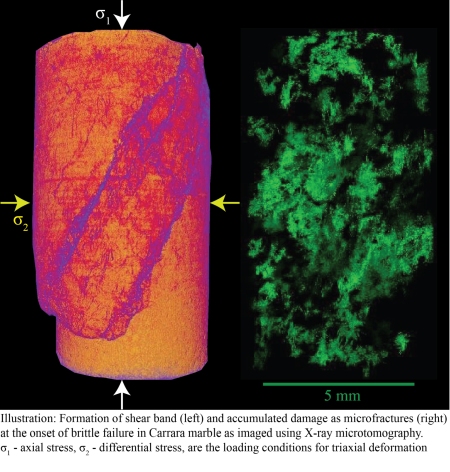The PhD defence and trial lecture are fully digital and streamed using Zoom. The host of the session will moderate the technicalities while the chair of the defence will moderate the disputation.
Trial lecture
The physics of sand dunes
Conferral summary (in Norwegian)
Geologiske fenomener som jordskjelv og dannelse av skjærsoner har mikrostrukturell opprinnelse. I avhandlingen er mikroskalamekanismer for sprø deformasjon i jordskorpen avbildet under in-situ situasjoner og ved bruk av synkrotron røntgenmikrotomografi. De eksperimentelle studiene tester for første gang teoretiske modeller på deformasjon/svikt i heterogene sprø bergarter, og identifiserer mekanismer for belastningslokalisering, inkludert tilstedeværelsen av forløpssignaler til jordskjelv.
Main research findings
Popular scientific article about Kandula’s dissertation:
Imaging brittle deformation in rocks of Earth’s crust using X-ray synchrotron

Majority of earthquakes originate at depths of 15-20 kilometers and may propagate on to the surface resulting in catastrophes. Predicting their occurrence is an important question in Earth science. These geological phenomena have microstructural origins and can be better understood when considering the material failure properties of rocks at microscale.
To investigate microscale deformation in centimetre-scale rock specimen, a special triaxial rock deformation apparatus, HADES (built in-house) is employed. Three-dimensional images of the microstructural deformation at every step increase in axial load are obtained using the technique of synchrotron X-ray micro tomography. A series of digital volumes of the rock microstructure is obtained until failure, which facilitates tracking the accumulation of damage, localization of strain and underlying microstructural mechanisms that govern failure in brittle rocks. Using a detailed analysis of microstructural evolution, this experimental study provide the first test of theoretical models of failure proposed for heterogeneous brittle rocks and identify mechanisms of strain localization and earthquake nucleation in them.
Photo and other information:
Press photo: Neelima Kandula, portrait; 500px. Photo: Helene Nøkland Lund
Other photo material: Figure with description and credit as specified in the article above, size 1500px.
